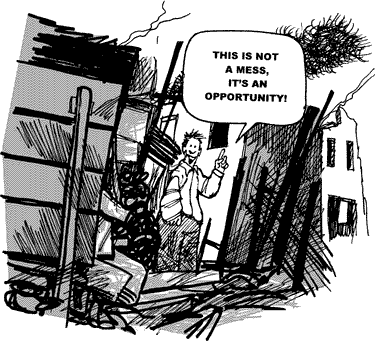Building Back Better
Creating a Sustainable Community After Disaster
by Jacquelyn L. Monday
It is time for an evolutionary nationwide shift in the approach now being used for coping with natural and technological hazards by universally adopting goals that are broader than local loss reduction; by using a revised framework that links natural hazards to their global context, to environmental sustainability, and to social resiliency; and by modifying hazard mitigation efforts so that they are compatible with that new vision.
Disasters by Design, p. 18Many hazards specialists in academia, all levels of government, and the private sector have spent much of the last decade promoting hazard mitigation—the permanent reduction of potential losses from natural and/or technological hazards. To a gratifying extent, these efforts have been rewarded. We now have more widespread acceptance—not just among policymakers and specialists, but also to a remarkable degree among the more general public—that reducing losses before they happen is preferable to cleaning them up over and over again, not to mention avoiding all the disruption and expense they entail. We have at our disposal an extensive array of mitigation techniques, ranging from engineering projects to construction techniques to insurance to forecasting to mapping. To an extent we would not have dreamed of a decade ago, the idea of mitigation has become intertwined with many public and private initiatives, laws, policies, and programs. There is even funding for mitigation. And yet...
Losses due to hazards continue to rise, and our disasters seem to be getting bigger. Indeed, this reality caused many in the field, a few years ago, to consider a mutinous thought: Not all “mitigation” is good.
To be sure, there may be any number of mitigation measures that are ill-conceived or poorly executed—as there inevitably are in any effort. And there are those that begin well but stray from their early vision along the way. But we have begun to realize that even mitigation techniques that are flawlessly designed and executed with the best of intentions and the fondest hopes can, in and of themselves, induce losses elsewhere.
For example, we now have the means to prevent or minimize storm surge damage to a house along the Gulf Coast, by elevating the home above the expected flood level, using certain construction materials and techniques. This combination of mitigation measures is now fairly widespread in both preventing disruption and misery for residents. But is it smart to make it feasible to build a home so close to the ocean? With more of our population converging gradually on the coasts, the the potential effects of such mitigation techniques must be considered at a much, much larger scale. Are we simply setting ourselves up for a bigger disaster when a severe hurricane hits?
Defining Sustainability
In the late 1980s, the World Commission on Environment and Development (the Brundtland Commission) came up with a definition of global sustainable development that has become widely accepted:
Sustainable development is development “that meets the needs of the present without compromising the ability of future generations to meet their own needs” (1987, p. 188).Or to take another instance, at present most of us would consider it wise mitigation to remove tornado-damaged mobile homes from their original site if that site happened to be a flood-prone area. But what if the mobile home park is the only source of low-income housing in a community? Is that not preventing a flood disaster by creating a financial and housing “disaster” for certain people?
It is clear from these examples and many other hypothetical situations that we can no longer afford to consider hazard mitigation in isolation from other aspects of community well-being. A broader context is needed to ensure that the attempts society makes to protect itself from hazards are not simply creating burdens for someone or someplace else, or simply postponing this year’s medium-sized disaster in favor of a really big one in the future. The concept of “sustainability” can provide an enlarged framework for examining potential mitigation measures—and any other community concerns—in a wider context.
